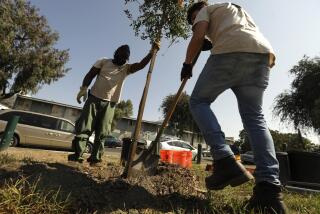Out on a Limb
- Share via
Mike Chiavetta built a Greene and Greene-style treehouse in his Huntington Beach backyard as a leafy retreat from the everyday world.
He said the cozy cabin reminds him of the pop song “Up On the Roof,” written by Carole King and Gerry Goffin, and made famous by James Taylor:
“When I come home feeling tired and beat / I’ll go up where the air is fresh and sweet / It’s peaceful as can be / and there the world below don’t bother me.”
Or so he thought.
In September, the Huntington Beach Planning Department ruled the treehouse violates city codes and must come down.
“There’s not an engineer in the world that would certify that tree,” code-enforcement officer Richard Hedden said. “We’re concerned that if the thing blew down, [neighborhood] children [on the ground] could be hurt.”
It was a storm that gave rise to the treehouse in the first place.
After a tornado rumbled through the neighborhood 10 years ago, Chiavetta cut the top off a large black pine tree in his backyard, fearing it could topple onto the house in another storm.
Then he read an article in Smithsonian magazine about treehouses that said the ideal base was a hand-shaped set of branches. Chiavetta recognized he was in luck.
Inspired by the elaborate adult treehouses in the books “Treehouses” by Peter Nelson and “Home Tree Home” by Nelson and Gerry Hadden, he built the 5- by 7-foot redwood and cedar structure in his garage, using salvaged materials and spending about $1,000 on new.
He hoisted it in pieces for reassembly atop the tree in April, with neighbors pitching in like an old-time barn-raising.
Now the tiny cabin houses a fold-up writing desk, a cushioned bench, framed citrus-crate labels, an autographed photo of astronaut Wally Schirra and stained-glass panels that Chiavetta made.
“This is our hideaway. I sit up here after work, after tapping on keys at a computer all day,” said Chiavetta, 54, an illustrator with Boeing. “I just want to sit up in the tree and draw.”
Sunrise is the best time, said his wife, Jeri, 52, a bridal-store manager. “Coffee up here, 5:30 a.m., is perfect.”
The city sees it less than perfect, classifying the treehouse as an “accessory structure,” like a shed or other outbuilding. As such, it violates the 15-foot maximum height limit and its base--the tree--is less than five feet from the neighbor’s property line.
Code-enforcement officer Hedden said his department received two complaints--”It’s not like we went looking”--that raised concerns about privacy.
To allay fears that the Chiavettas are spying on their neighbors below, Mike Chiavetta boarded the windows facing those backyards.
“I tried to be as conscientious as possible, I tried to make it as invisible as possible and I tried to be as friendly as possible,” Chiavetta said.
But from the city’s viewpoint, privacy is “not the issue,” Hedden said. “It’s strictly a safety issue on our part.”
The Chiavettas face an Oct. 30 deadline. If the city doesn’t change its position, the couple can apply to the Planning Department for a variance, a process that costs $780 to $1,080, and can take two to six months. If they’re denied, they can appeal to the City Council.
“We are willing to do whatever it takes to save the treehouse,” Jeri Chiavetta said.
*
Arthur Kent, a Huntington Beach-based architect and part-time instructor at Golden West College, cautions that anyone considering a treetop retreat should understand the ground rules.
“Any time you build anything, you need to first review with the city Planning Department, and make sure you’re not going to run into these kinds of problems,” Kent said. “If anybody does complain, then you have the documentation from the city.”
Mike Chiavetta thought he was treading on safe ground, however. A few years ago his next-door neighbors built a treehouse for their children. City inspectors got wind of that one and checked it out.
Chiavetta said he remembers the inspector at the time saying that as long as the treehouse was supported entirely by the tree, and didn’t have electricity or plumbing connections, “the sky’s the limit.”
He admits he didn’t want to know much more than that: “It’s like, if you ask permission, they’re going to say ‘no.’ ”
But Hedden said Chiavetta could have saved himself some grief by consulting city inspectors.
“He put a lot of time into it. If he had taken it a step further” and checked with the Planning Department, Hedden said, “it would’ve been a big help to him.”
More to Read
Sign up for Essential California
The most important California stories and recommendations in your inbox every morning.
You may occasionally receive promotional content from the Los Angeles Times.












